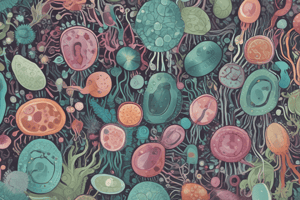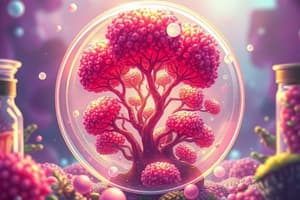Podcast
Questions and Answers
What role do nodules play in the process of nitrogen fixation?
What role do nodules play in the process of nitrogen fixation?
Nodules house Rhizobium bacteria that convert atmospheric nitrogen into ammonia.
Explain the importance of nitrifying bacteria in the soil.
Explain the importance of nitrifying bacteria in the soil.
Nitrifying bacteria convert ammonia into nitrites and then into nitrates, making nitrogen available for plant use.
Describe how atmospheric nitrogen becomes usable for plants.
Describe how atmospheric nitrogen becomes usable for plants.
Atmospheric nitrogen is converted to ammonia by nitrogen-fixing bacteria, which is then transformed into nitrates by nitrifying bacteria.
What is the process of ammonification?
What is the process of ammonification?
How do lightning and combustion contribute to the nitrogen cycle?
How do lightning and combustion contribute to the nitrogen cycle?
Identify two forms in which nitrogen is absorbed by plants.
Identify two forms in which nitrogen is absorbed by plants.
What happens to the nitrogen in organisms after they die?
What happens to the nitrogen in organisms after they die?
How do plants assimilate nitrogen from the soil?
How do plants assimilate nitrogen from the soil?
What did Joseph Lister contribute to surgical practices?
What did Joseph Lister contribute to surgical practices?
In what environments can microorganisms be found?
In what environments can microorganisms be found?
What are the conditions necessary for the growth of most microorganisms?
What are the conditions necessary for the growth of most microorganisms?
What role do bacteria and fungi play in increasing soil fertility?
What role do bacteria and fungi play in increasing soil fertility?
What distinguishes aerobic microorganisms from anaerobic microorganisms?
What distinguishes aerobic microorganisms from anaerobic microorganisms?
What role do bacteria play in the making of curd?
What role do bacteria play in the making of curd?
How do photosynthetic microorganisms obtain their energy?
How do photosynthetic microorganisms obtain their energy?
How is vinegar produced from fruits?
How is vinegar produced from fruits?
What are some uses of algae in the food industry?
What are some uses of algae in the food industry?
What types of microorganisms are considered saprophytes and what is their role?
What types of microorganisms are considered saprophytes and what is their role?
Why are antibiotics important in medicine?
Why are antibiotics important in medicine?
Explain the term 'parasite' in relation to microorganisms.
Explain the term 'parasite' in relation to microorganisms.
How do antibodies function in the immune response?
How do antibodies function in the immune response?
How does refrigeration prevent food spoilage?
How does refrigeration prevent food spoilage?
How does pasteurization work and what is its significance?
How does pasteurization work and what is its significance?
What preventive measure can be taken against typhoid fever?
What preventive measure can be taken against typhoid fever?
What is food preservation and why is it important?
What is food preservation and why is it important?
What is the significance of producing specific antibodies against an antigen?
What is the significance of producing specific antibodies against an antigen?
What is the source of penicillin and what is its role?
What is the source of penicillin and what is its role?
What types of illnesses can antibiotics treat?
What types of illnesses can antibiotics treat?
What role does sugar play in the preservation of fruits?
What role does sugar play in the preservation of fruits?
Describe the method of canning in food preservation.
Describe the method of canning in food preservation.
Explain the process of sun drying and its effect on food preservation.
Explain the process of sun drying and its effect on food preservation.
What are the main signs of gastroenteritis and how is it spread?
What are the main signs of gastroenteritis and how is it spread?
Which bacterium is responsible for cholera and how is it primarily spread?
Which bacterium is responsible for cholera and how is it primarily spread?
What are the ideal conditions for the survival of most microorganisms?
What are the ideal conditions for the survival of most microorganisms?
How do denitrifying bacteria contribute to the nitrogen cycle?
How do denitrifying bacteria contribute to the nitrogen cycle?
What are the primary carriers of microbes that can lead to diseases such as malaria and dengue fever?
What are the primary carriers of microbes that can lead to diseases such as malaria and dengue fever?
Describe the method of transmission for poliomyelitis and one of its symptoms.
Describe the method of transmission for poliomyelitis and one of its symptoms.
Identify a symptom of tuberculosis and mention its method of spread.
Identify a symptom of tuberculosis and mention its method of spread.
What common symptom is associated with ringworm, and how does the infection typically spread?
What common symptom is associated with ringworm, and how does the infection typically spread?
How does the common cold typically spread and what are its symptoms?
How does the common cold typically spread and what are its symptoms?
What disease is caused by the protozoa Plasmodium and how is it commonly transmitted?
What disease is caused by the protozoa Plasmodium and how is it commonly transmitted?
Name one disease transmitted by space contamination and its preventive measures.
Name one disease transmitted by space contamination and its preventive measures.
Study Notes
Microorganisms
- Microorganisms are found in diverse environments, including inside other organisms.
- A single gram of soil can contain millions of bacteria, while the human scalp has hundreds of millions.
- Microorganisms are found in the air, clothes, skin, fingernails, and intestines.
Growth Conditions
- Microorganisms have varying needs for growth:
- Oxygen: Many need oxygen for respiration (aerobic), while others don't (anaerobic).
- Water: Essential for most to thrive.
- Temperature: Ideal range is 25-38 °C, though some tolerate extreme temperatures.
- Darkness: Many thrive in darkness, but photosynthetic microorganisms need light.
- Food: They utilize a wide range of materials, including dead organisms (saprophytes) and living tissues (parasites).
Useful Microorganisms
- Bacteria and fungi decompose organic matter, enriching soil fertility.
- Rhizobium bacteria fix nitrogen in legume root nodules, increasing soil nitrogen content for plant growth.
Nitrogen Fixation
- Nitrogen is abundant in the atmosphere, but most organisms cannot use it directly.
- Nitrogen-fixing bacteria convert atmospheric nitrogen to ammonia, then to nitrites and nitrates, making it usable by plants.
- This process is called nitrogen fixation.
- Plants absorb nitrates, animals consume plants or other animals for their nitrogen needs.
Nitrogen Cycle
- Nitrifying bacteria fix ammonia into usable nitrates.
- Lightning and combustion reactions produce nitrogen oxides that form nitrates in soil.
- Plants absorb nitrates and incorporate them into proteins.
- Decomposers break down dead organisms, releasing ammonia, restarting the cycle.
Food Industry
- Bacteria convert lactose in milk to lactic acid, creating curd and cheese.
- Yeast converts sugar to alcohol, which bacteria further convert to vinegar.
- Algae are used as food stabilizers, thickeners, and sources of food.
Antibiotics
- Fungi and bacteria produce antibiotics like penicillin and streptomycin, respectively.
- Antibiotics kill or inhibit growth of disease-causing microbes without harming the host.
Immunity and Vaccines
- Antigens are foreign substances or microbes that trigger antibody production in the body.
- Antibodies are specific proteins that target and destroy specific antigens.
Disease Transmission
- Microorganisms can spread through:
- Insects: mosquitos, fleas, and flies carry microbes.
- Animal bites: rabies spreads through animal bites.
Food Preservation
- Food preservation methods prevent spoilage and extend shelf life:
- Canning: Sealed, airtight containers.
- Pasteurization: Heat treatment followed by rapid cooling.
- Sun drying: Water removal inhibits microbial growth.
- Salting: Salt inhibits microbial growth.
- Pickling: Preserving in vinegar or brine.
- Adding sugar: Sugar removes water, preventing microbial growth.
- Refrigeration: Freezing inhibits but doesn't kill microbes.
Studying That Suits You
Use AI to generate personalized quizzes and flashcards to suit your learning preferences.
Related Documents
Description
Explore the fascinating world of microorganisms, their diverse environments, and the essential conditions for their growth. From the need for oxygen to the importance of temperature, this quiz covers key aspects of microbial life and their contributions to ecosystems.




